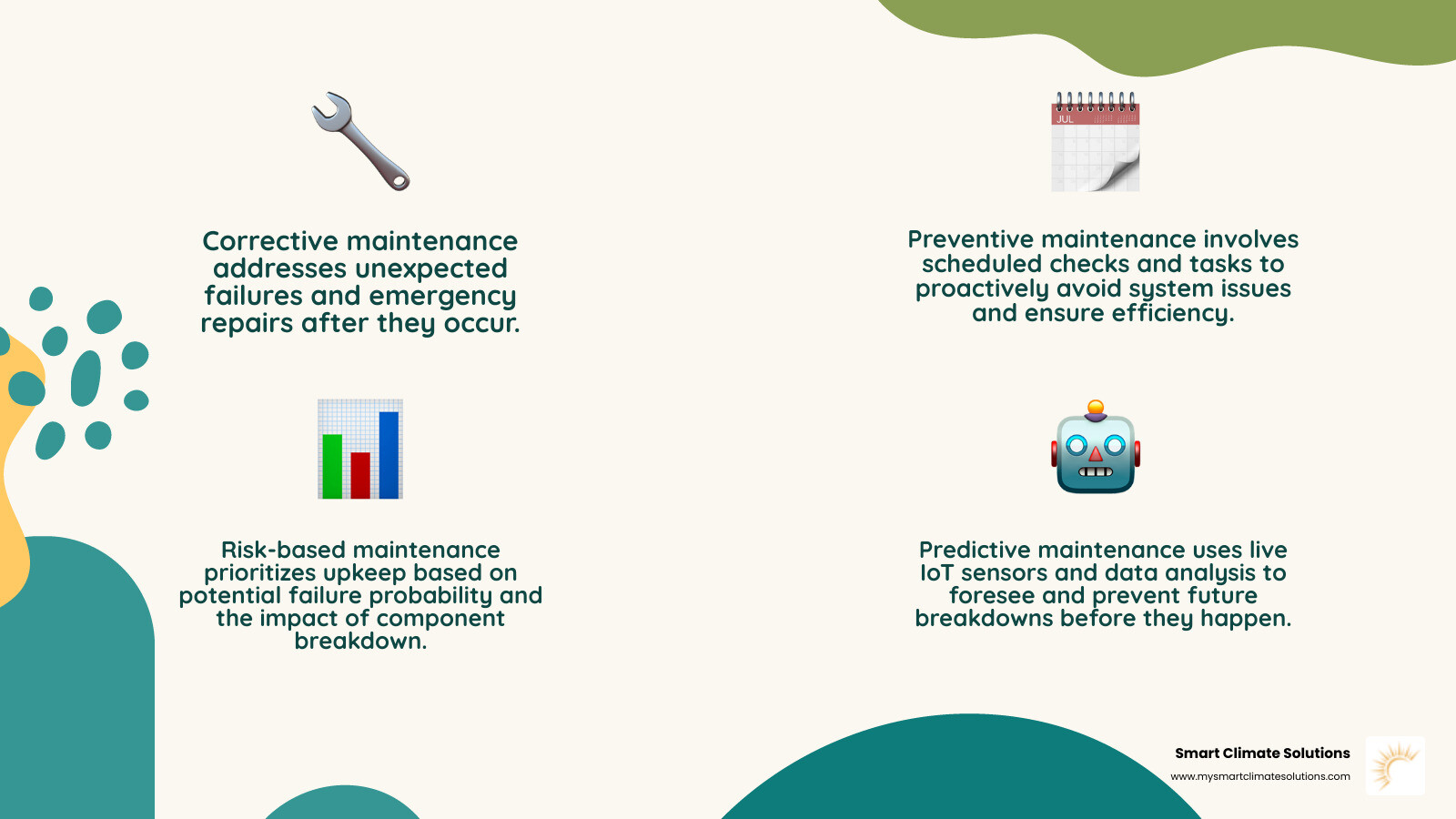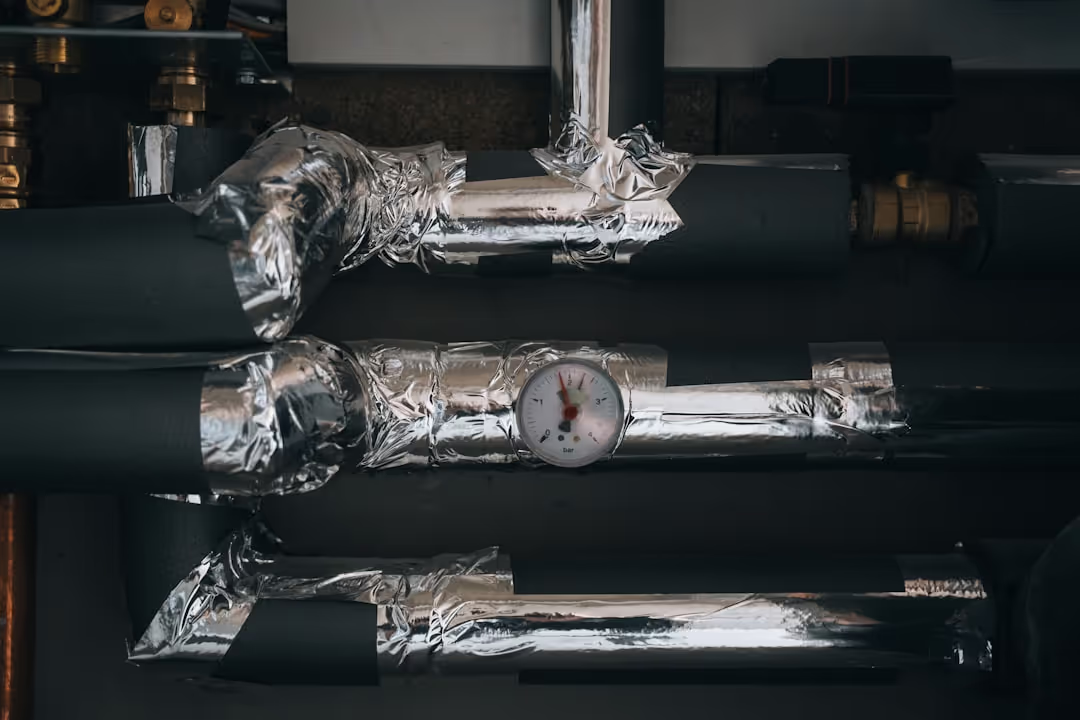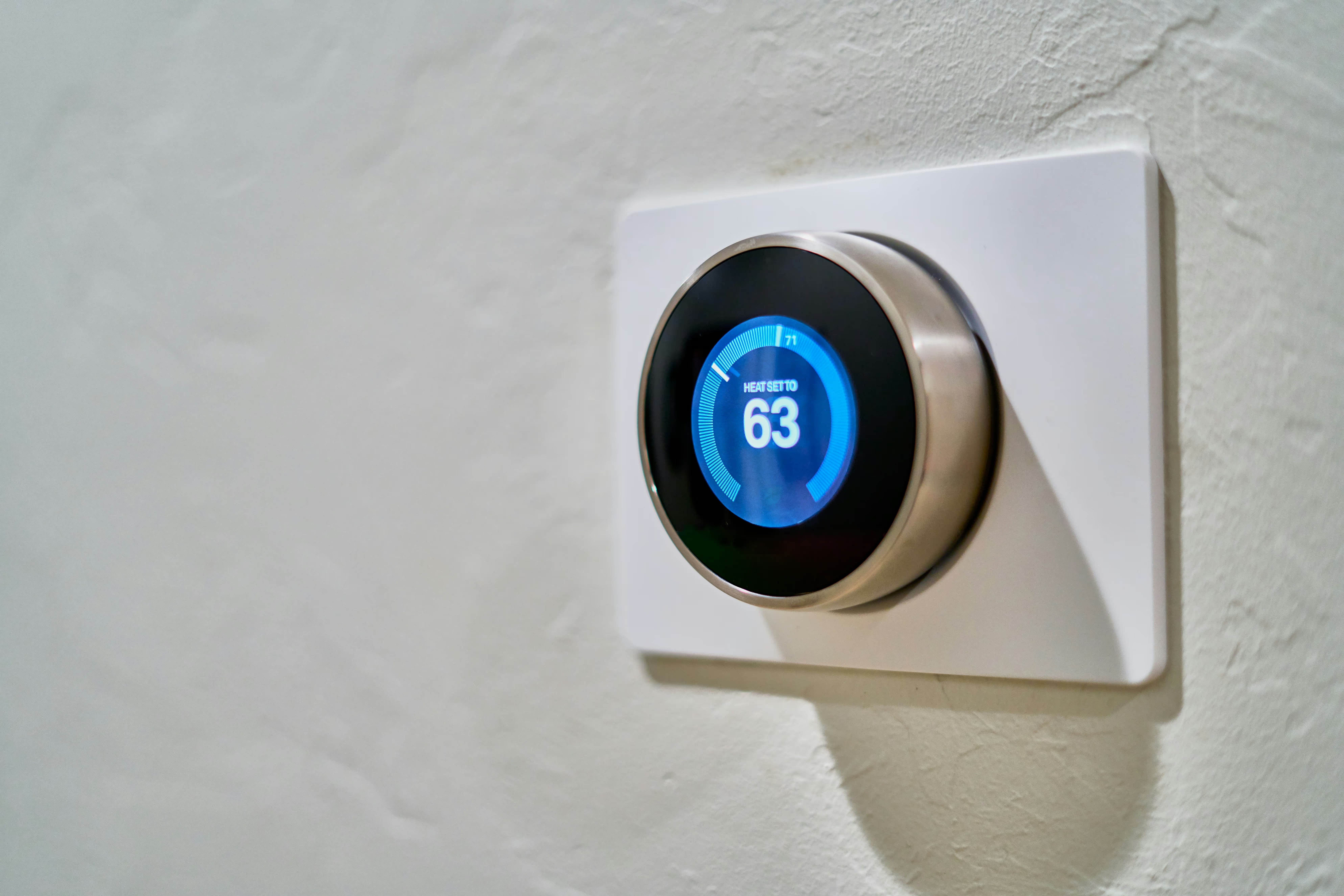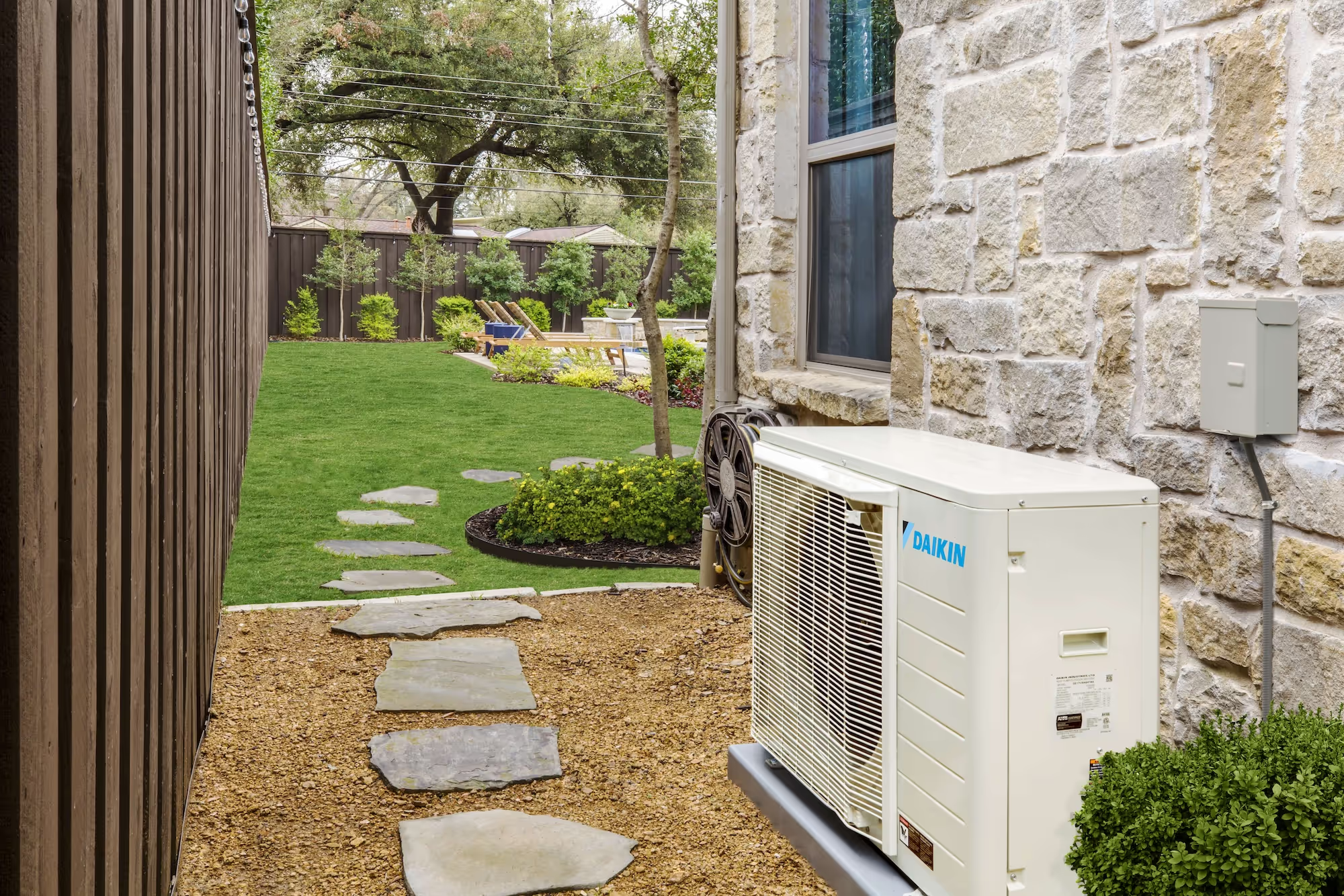Understanding the Core of HVAC Maintenance
Keeping your home comfortable year-round often hinges on a well-maintained HVAC system. But what are the 4 phases of planned maintenance hvac that truly keep things running smoothly?
Here's a quick look at these essential phases:
- Corrective Maintenance: Fixing problems after they happen.
- Preventive Maintenance: Scheduled checks and tasks to avoid issues.
- Risk-Based Maintenance: Prioritizing maintenance based on potential failure risks.
- Predictive Maintenance: Using data and technology to foresee problems before they occur.
Planned HVAC maintenance isn't just about fixing things when they break. It's a smart, preventive approach that schedules and organizes regular upkeep. This helps you avoid unexpected breakdowns and extend the life of your equipment.
In fact, regular HVAC maintenance can:
- Reduce the risk of costly breakdowns by up to 95%.
- Help lower energy bills by up to 30% by making your system more efficient.
- Extend your system's lifespan by several years, preventing early replacements.
Understanding these phases means you can be proactive. It helps ensure your system works efficiently and reliably, keeping your home comfortable without surprising you with big repair bills.
I'm Bill Scott, General Manager of Smart Climate Solutions. With over 20 years in the HVAC industry, I've seen how understanding what are the 4 phases of planned maintenance hvac truly makes a difference for homeowners like you. Let's dive deeper into each phase and see how they work together to protect your home's comfort.

What are the 4 phases of planned maintenance hvac helpful reading:
- ac maintenance plan
- are hvac maintenance plans worth it
- preventive maintenance schedule for air conditioner
What Are the 4 Phases of Planned Maintenance HVAC?
When we talk about planned HVAC maintenance, we're not just hinting at a quick annual check-up. Oh no, it's so much more! We're talking about a smart, comprehensive strategy. It uses different approaches to keep your heating and cooling system running its very best. This means it works efficiently, keeps you comfortable, and lasts for years and years. These four phases work together, changing your HVAC care from a "fix it when it breaks" scramble to a proactive, data-driven plan.
Think of it like having different tools in your toolkit, each perfect for a specific job. Let's take a quick peek at how these phases compare, laying out their unique roles:
| Maintenance Type | Approach | Trigger | Goal | Key Characteristic |
|---|---|---|---|---|
| Corrective | Reactive | Failure or defect | Restore function | Immediate fix, often unplanned |
| Preventive | Scheduled | Time, usage, or condition | Avoid failure | Proactive, routine upkeep |
| Risk-Based | Prioritized | Performance data, failure probability | Optimize resources | Focus on high-impact components |
| Predictive | Data-Driven | Real-time sensor data, anomaly detection | Forecast failure | Advanced, technology-intensive |
Understanding the little differences in each phase is super important. It helps us maximize your HVAC system's performance, stretch its lifespan, and keep those energy bills happily low. This integrated way of doing things helps us cut down on costly downtime. It also boosts energy efficiency and significantly extends the lifespan of your valuable HVAC equipment.
For even more insights into the power of proactive care, dive into the latest research on preventive maintenance.
Corrective Maintenance: Reactive Fixes
Picture this: It's the hottest day of summer, you're looking forward to that cool blast, and suddenly, your AC just... stops. No cool air. Nothing. That's when corrective maintenance swings into action. This phase is all about jumping in to fix unexpected failures or problems after they happen. It's the classic "fix it when it breaks" approach, and our main goal here is to get your system back up and running as fast as humanly possible.
While it might sound like the opposite of "planned," corrective maintenance does have its place. Sometimes, for parts that aren't super vital, or where the cost of downtime and repair is actually less than setting up a full, fancy maintenance plan, a quick reactive fix is the most sensible path. However, relying only on corrective maintenance for your whole HVAC system can lead to bigger, more expensive problems down the road. Plus, it usually calls for quick responses, especially for your home's main comfort system, to keep discomfort or bigger headaches to a minimum. We've certainly seen how a small, ignored issue can quickly balloon into a major, costly repair if it's not handled promptly.
Preventive Maintenance: Scheduled Care
Ah, now this is where the true magic of "planned" really shines! Preventive maintenance is all about taking smart, proactive steps to stop problems before they even think about starting. It means we perform scheduled tasks and inspections at regular times, whether your system seems to have a problem or not. Think of it like getting regular check-ups for your own health - you do them to stay feeling great, not just when you're feeling under the weather!
Our preventive maintenance includes a variety of key, time-based tasks, like:
- Filter Changes: This is one of the simplest but most powerful things you can do! Regularly swapping out dirty air filters ensures proper airflow, boosts your indoor air quality, and helps your system run like a dream.
- Coil Cleaning: Over time, those evaporator and condenser coils can get gunked up with dirt and debris, making it harder for your system to cool or heat efficiently. Cleaning them is vital for keeping that energy efficiency high and preventing strain on your system.
- Annual Inspections: These are our big, thorough check-ups. We often schedule them in the spring for your AC and in the fall for your heating. We'll look for wear and tear, tighten electrical connections, lubricate moving parts, and test safety controls. These inspections are also key to ensuring CO safety by checking for proper combustion and venting.
- Component Replacements: Sometimes, based on what the manufacturer suggests and how long parts typically last, we might replace certain components before they fail. This helps prevent those surprising, inconvenient breakdowns.
A huge bonus of consistent preventive maintenance? It helps with warranty compliance. Many HVAC manufacturers actually require documented regular servicing to keep your warranty valid. By keeping detailed maintenance records, you help ensure that any big issues covered by the warranty will be honored. This proactive approach helps us catch minor issues before they become major headaches, significantly improving your home's indoor air quality and reducing the risk of nasty surprises like carbon monoxide poisoning.
Risk-Based Maintenance: Data-Driven Prioritization
Moving beyond just fixed schedules, risk-based maintenance takes a much smarter, more focused approach. This phase involves digging into historical performance data, figuring out how critical each piece of equipment is, and looking at the probability and impact of potential failures. This helps us prioritize which maintenance tasks need our attention most. It's like asking, "Where are we most likely to have a hiccup, and what would be the biggest headache if it actually broke down?"
For instance, if your system's compressor has a history of acting up, or if it's a super expensive part to replace, we might decide it needs more frequent checks or deeper diagnostic tests. We use past performance numbers and failure data to guide our prioritization, making sure our efforts are focused where they'll make the biggest difference. This helps us put our maintenance resources to work most effectively, instead of just treating every part the same. By ranking potential shutdown risks, we can really zero in on inspecting the parts that matter most for your comfort. This intelligent approach can greatly extend your system's lifespan.
Predictive Maintenance & IoT Monitoring
Now we're talking about the cutting edge of HVAC care! Predictive maintenance, sometimes called condition-based maintenance, goes a step beyond risk-based. It uses real-time data and advanced analytics to figure out the actual condition of your equipment. Instead of just going by past trends or set schedules, it only triggers maintenance when it's truly needed - often just before a problem is likely to pop up. This is a truly "good approach" for keeping things running smoothly.
So, how does this futuristic approach work? It often includes:
- Live Sensors: We install smart IoT sensors on key parts of your HVAC system. These little gadgets constantly watch things like temperature, pressure, vibration, motor current, and how much air is flowing.
- Data Collection & Analysis: All that information gathered by the sensors is constantly streamed and crunched by special software and smart algorithms.
- Anomaly Detection: These clever algorithms are designed to spot tiny changes or odd behaviors in performance that hint at a problem starting. For example, a slight buzz in the motor might signal a bearing that's about to go.
- AI Alerts: When something unusual is detected, the system sends out an alert. This tells us that a specific part needs attention. This lets us send a technician for condition-based actions, addressing the issue proactively before it becomes a real headache.
Predictive maintenance is fantastic because it helps us reduce surprise outages and avoid doing maintenance that isn't really needed. By catching issues before they get big, we can often do repairs during off-peak hours or even before a complete breakdown occurs. This saves you from uncomfortable situations and those costly emergency repairs.
Summary: what are the 4 phases of planned maintenance hvac at a glance
So, let's quickly recap what are the 4 phases of planned maintenance hvac:
- Corrective Maintenance: This is the reactive approach, fixing issues after they break. It's best for parts that aren't critical, or when an immediate repair is simply more practical than prevention.
- Preventive Maintenance: This is our proactive, scheduled care. We perform routine tasks to prevent breakdowns and extend your system's lifespan. It's absolutely crucial for overall system health and keeping your warranty valid.
- Risk-Based Maintenance: This is the strategic phase. We prioritize maintenance efforts based on the probability and impact of potential component failures. It's all about making the most of our resources.
- Predictive Maintenance: This is the advanced, tech-savvy approach. We use real-time data and smart sensors to forecast failures and trigger maintenance just before they happen. This minimizes downtime and maximizes efficiency.
These phases really form a progressive journey. We move from just reacting to problems to actively anticipating and preventing them. A truly effective HVAC maintenance plan usually mixes and matches elements from all four. It's custom to the specific needs and importance of your system. It's about finding that perfect balance to make sure your home stays comfortable, your energy bills stay low, and your system keeps going strong for many, many years to come.
Maintenance Frequency & Pro Tips
Understanding what are the 4 phases of planned maintenance hvac is a huge step. But knowing when to apply them is just as important! Think of it like taking care of your car - you wouldn't wait for a breakdown to get an oil change, right? Regular, timely maintenance is the secret sauce for a healthy HVAC system.
Generally, experts suggest getting your HVAC system serviced at least once a year. This annual check-up helps keep things humming along. However, if your system is a bit older (say, 10 years or more), or if it works extra hard (like in homes with lots of pets, allergies, or constant use), we often recommend a semi-annual schedule. That means two visits a year - typically one in the spring before the cooling season kicks in, and another in the fall before the heating season begins. This way, your system is always ready for whatever the weather throws at it!
Here are some of our best "pro tips" for keeping your HVAC system in tip-top shape:
- Track Runtime Hours: For some advanced systems, we don't just go by the calendar. We might look at how many hours your system has actually been running. This "usage-based" approach makes sure maintenance is done when it's truly needed, reflecting how hard your system is working for you.
- Use Checklists: When our technicians visit, they follow a detailed checklist. This ensures every single component is inspected, cleaned, and tested. No stone is left unturned, so you can be confident your system is thoroughly checked.
- Documentation is Key: We keep detailed records of every service visit. This includes dates, tasks completed, any parts replaced, and anything special we noticed. Good documentation is super important for keeping your warranty valid and helps us track your system's health over time. It's like a health record for your home's comfort system!
- Prioritize Indoor Air Quality: Beyond just making your system run well, regular maintenance dramatically improves the air you breathe. Simple things like changing filters and cleaning coils reduce allergens and pollutants. Plus, it's a critical safety measure, helping prevent issues like carbon monoxide buildup by making sure everything is ventilating properly.
How Often to Schedule Maintenance Visits
So, how often should you actually schedule those visits for what are the 4 phases of planned maintenance hvac? It really boils down to a few key factors:
- Annual vs. Semi-Annual: As we mentioned, an annual tune-up is the bare minimum for most modern systems. This usually covers essential preventive checks. But for older systems (those 10+ years old), homes with pets or allergies, or systems that run almost constantly, going semi-annual (that spring and fall visit) is a smart move. More frequent checks mean more regular filter changes, coil cleaning, and a better chance to catch small issues before they become big, expensive headaches.
- Usage-Based Triggers: Some super-smart systems and advanced thermostats can actually track how many hours your unit is running. Instead of just scheduling by the calendar, we can use this data to trigger maintenance only when your system has put in a certain amount of work. This is super efficient, especially if your system's usage changes a lot throughout the year.
- Smart Thermostat Data: Your modern smart thermostat isn't just for setting the temperature! Many provide helpful insights into your system's performance and can even flag potential issues or inefficiencies. This data can be a great clue for when a professional check-up might be beneficial, even if it's outside your regular schedule.
Our main goal is to help you find the perfect maintenance frequency that balances what you spend with getting the best performance and longest life out of your HVAC system. We're here to help you figure out the best plan for your specific home and needs!
Dollars & Sense: Benefits and ROI of a 4-Phase Plan
Let's talk numbers - because when it comes to what are the 4 phases of planned maintenance hvac, the math is pretty compelling. Think of planned HVAC maintenance like buying insurance for your comfort and your wallet. The upfront investment pays for itself many times over.
Here's where the real savings kick in: A well-maintained system can slash your utility bills by up to 30%. This isn't just a nice-to-have; it's serious money back in your pocket every month. When your system is clean and running smoothly, it doesn't have to work overtime to keep you comfortable. Clean coils transfer heat better, fresh filters allow proper airflow, and calibrated components work in harmony instead of fighting each other.
But the savings don't stop there. Regular maintenance can extend your system's lifespan by 5-7 years. Consider this: a new HVAC system can cost anywhere from $5,000 to $15,000 or more. If you can delay that replacement by even a few years through proper care, you're looking at substantial savings. It's like getting free years of comfort just by taking care of what you already have.
Statistic we mentioned earlier? Planned maintenance can reduce costly breakdowns by up to 95%. That means fewer emergency calls, no more scrambling for after-hours repairs when your AC quits on the hottest day of summer, and no more shivering while waiting for a technician during a winter cold snap.
The comfort benefits are just as valuable. A properly maintained system keeps your home at consistent temperatures and humidity levels. Clean filters and coils mean better indoor air quality - fewer allergens, less dust, and cleaner air for your family to breathe. When your system runs efficiently, it also leaves a smaller carbon footprint, using less energy to keep you comfortable.
Here's a smart budgeting tip: Instead of viewing maintenance as a big annual expense, try setting aside a small amount each month. Maybe $20-30 monthly into a "home comfort fund." This makes seasonal tune-ups feel much more manageable, and you'll never be caught off guard by a sudden repair bill.
Many homeowners skip maintenance because they think it's expensive or unnecessary. But the reality is quite the opposite - it's one of the most cost-effective investments you can make in your home. When you understand the four phases of planned maintenance and put them to work, you're not just spending money - you're protecting a major investment while keeping your family comfortable year-round.
Frequently Asked Questions about Planned HVAC Maintenance
It's totally normal to have questions about your home's HVAC system! We know that thinking about what are the 4 phases of planned maintenance hvac can sometimes feel a bit overwhelming. But don't worry, we're here to clear things up and address some of the most common questions homeowners have. Let's get you some quick, straightforward answers!
What is the difference between preventive and predictive maintenance?
This is a fantastic question, and it's one we hear often! These two terms sound similar, but they actually describe different approaches to keeping your system humming.
Think of preventive maintenance like your annual physical exam. You schedule it regularly, perhaps every year or six months, regardless of whether you feel sick. The idea is to catch potential issues early, clean things up, and make minor adjustments to prevent bigger problems from happening down the road. It's all about following a fixed schedule or a general usage guideline. We perform tasks like cleaning filters, checking coils, and doing general inspections on a consistent timetable.
Now, predictive maintenance is a bit more advanced. Imagine having a smart watch that constantly monitors your health, not just when you go for your annual check-up. This watch could alert you if your heart rate shows a tiny, unusual pattern, before you even feel unwell. That's what predictive maintenance does for your HVAC system! It uses clever sensor technology (often called IoT sensors) that constantly gathers real-time data about your system's performance. These sensors can detect tiny changes (like a slight vibration or a small temperature shift) that signal a part might be about to fail. We then step in just before a breakdown happens, saving you from a surprise outage.
So, the key difference is: preventive is about scheduled care to avoid problems, while predictive uses real-time data to forecast when a problem will occur, allowing for perfectly timed, "condition-based" actions.
Can I perform any of the four phases myself?
That's a very practical question! While a lot of the specialized work for what are the 4 phases of planned maintenance hvac truly needs a professional touch, there are definitely things you can do yourself to help your system run better and stay healthy. Think of it as teamwork!
The biggest and best DIY task you can tackle is changing your air filters regularly. This is a simple but mighty task! A clean filter keeps air flowing freely, improves your indoor air quality, and helps your system work more efficiently. We usually recommend checking them every month and changing them every 1 to 3 months, depending on how often your system runs and if you have pets.
You can also make sure that your indoor vents aren't blocked by furniture or drapes, allowing air to circulate freely. And outdoors, keep the area around your AC unit clear of leaves, grass clippings, and other debris. Giving it some breathing room helps it work better.
However, for the deeper dives - like checking refrigerant levels, cleaning coils thoroughly, inspecting electrical connections, or diagnosing strange noises - it's always best to call in the pros. These tasks require special tools, training, and a keen eye for safety. Trying to tackle complex repairs yourself can accidentally lead to more damage, might even void your warranty, and can pose safety risks. When in doubt, a quick call to us is always the safest bet!
Does planned maintenance affect warranty coverage?
This is a really important point, and the short answer is: yes, absolutely!
Many HVAC manufacturers actually require regular professional maintenance to keep your system's warranty valid. Think of it like this: they're guaranteeing their product, but they expect you to take good care of it. If a major part breaks down and your system hasn't been regularly serviced and documented, the manufacturer might say, "Sorry, but you didn't follow the terms," and then you're left paying for a costly repair or even a full replacement yourself.
That's why keeping good records of all your maintenance visits is super important. It's your proof! We make sure to thoroughly document every service we perform for you, including the dates, what we did, and any parts we replaced. This way, if you ever need to make a warranty claim, all the paperwork is in order, protecting your investment and giving you peace of mind.
Conclusion
So, you've now found that understanding what are the 4 phases of planned maintenance hvac is truly the secret to a happy, healthy home. It's about getting the most comfort, efficiency, and long life out of your heating and cooling system. We've seen how each phase - from quick fixes to scheduled check-ups, smart prioritization, and even predicting future issues - works together seamlessly. This complete approach does so much more than just prevent expensive breakdowns. It also helps your system last longer, cuts down your energy bills, makes your indoor air cleaner, and keeps your family perfectly comfortable, all year round.
Here at Smart Climate Solutions, we really believe that a well-maintained HVAC system means a happy home. We're proud to offer fast, reliable service with our certified technicians. With over 15 years of experience, we're dedicated to making sure you're comfortable and completely satisfied.
Why wait for a problem to pop up? You now know the power of planned maintenance.
Ready to put these four smart phases into action for your home? Let's get your system running its very best.








.png)
